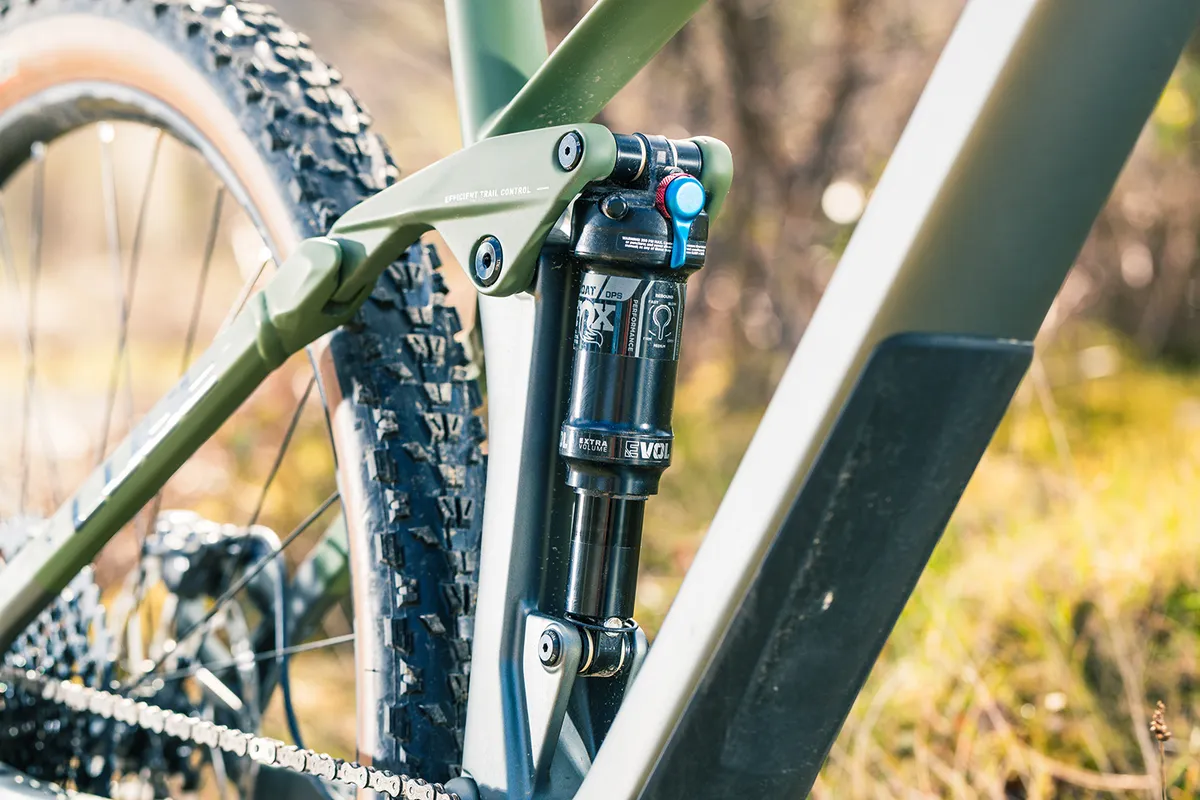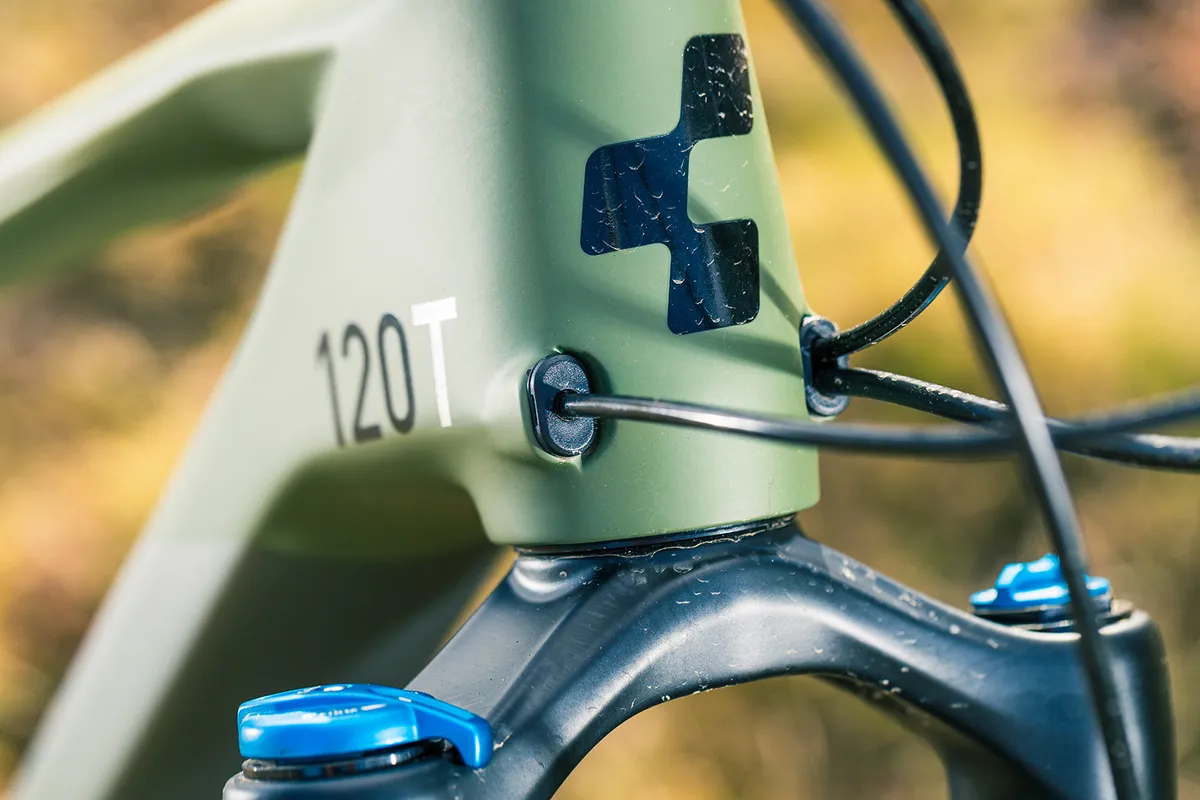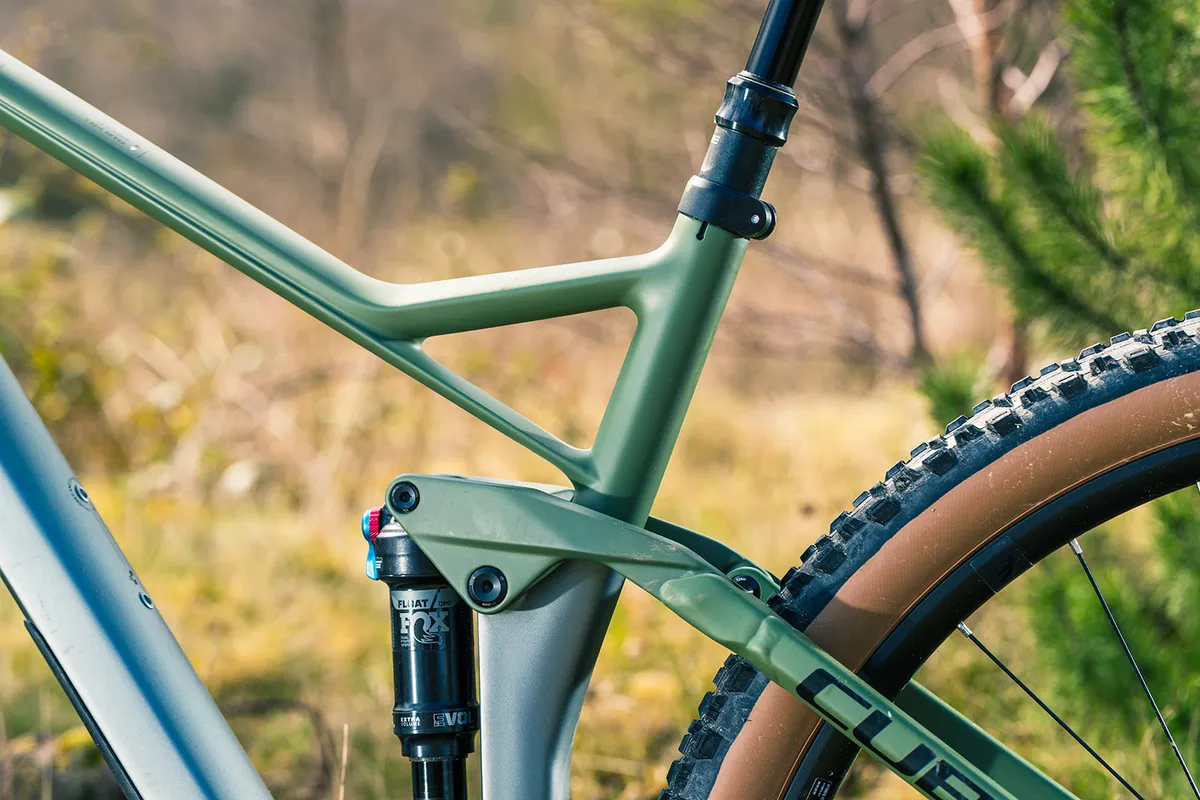Cube’s Stereo 120 HPC TM is a 120mm-travel trail bike, with a mixed carbon front and alloy rear end. Up front, there’s 130mm of suspension via a Fox 34 fork.
The spec list has some clear highlights, including punchy brakes and a stubby stem that suggests nimble handling.
At the same time, the shorter travel on offer, along with some of Maxxis’ faster-rolling tyres, indicates that this bike might suit riders looking for all-day adventures, rather than wild days on the hillside.
Cube Stereo 120 HPC TM frame and suspension details

A classic four-bar suspension layout is used by Cube to dole out 120mm of rear travel, with the architecture around the pivots nicely formed, giving a classy finish to the frame.
Up front, a carbon triangle holds internal cable routing, with the cables entering the head tube straight-on, minimising the risk of cable rub.
Cables are then guided through the frame, emerging just ahead of the rear pivot, ready to pull the derailleur or push hydraulic fluid into the brake caliper.

The rear triangle is built from aluminium, saving money but adding a touch of weight – a common concession on mid-priced trail bikes.
The top tube is straight, but drops fairly low down the seat tube, with a brace supporting the top of the seat tube, aiding standover.
The shock sits vertically by the seat tube, giving room for the single bottle-cage mounting point on the inside of the triangle.
Cube Stereo 120 HPC TM geometry

This generation of the Stereo errs on the more traditional side of geometry, indicated by shorter lengths and steeper head and slacker seat angles than many other current trail bikes.
On my size-large test bike, the 460mm reach might be considered short these days, while the 66.8-degree (measured, 0.2 degrees slacker than claimed) head angle isn’t as slack as many of its competitors.
The 75.4-degree seat angle (measured with the saddle at 71cm from the bottom bracket) is slacker than many too, while the 470mm seat tube is longer than most.

On paper, this suggests a less aggressive feel to the bike, being taller and steeper than most.
It is, however, limited to 120mm of travel. Therefore, aspects such as the seat tube angle may be excused. As the suspension sags, the seat angle decreases – longer-travel bikes with more sag would exacerbate this feeling more.
If we view this as a ‘downcountry’ bike, the angles are less conservative, but still aren’t progressive.
| | S | M | L | XL |
|---|---|---|---|---|
| Seat angle (degrees) | 75.3 | 75.3 | 75.3 | 75.3 |
| Head angle (degrees) | 67 | 67 | 67 | 67 |
| Chainstay (mm) | 435.5 | 435.5 | 435.5 | 435.5 |
| Seat tube (mm) | 370 | 420 | 470 | 520 |
| Top tube (mm) | 570 | 591 | 614 | 640 |
| Head tube (mm) | 102 | 105 | 115 | 135 |
| Bottom bracket drop (mm) | 40 | 40 | 40 | 40 |
| Wheelbase (mm) | 1,148 | 1,169 | 1,193 | 1,221 |
| Standover (mm) | 741 | 740 | 747 | 775 |
| Stack (mm) | 603 | 606 | 615 | 633 |
| Reach (mm) | 420 | 440 | 460 | 480 |
Cube Stereo 120 HPC TM specifications

Cube has gone to a broad range of suppliers for the kit on the bike. Suspension comes from Fox in the form of a 34 Rhythm fork with 130mm travel, while there’s a Float DPS shock at the rear.
The fork has a GRIP damper, which I like, while the shock features a three-position compression switch to firm up or free up the shock.
A mixed SRAM SX/NX/GX Eagle drivetrain drives the bike forward, while a powerful Shimano XT four-piston brake at the front, paired with a two-pot at the back, should bring it to a halt quickly, especially considering the 203/180mm rotor combo.

Wheels come from Fulcrum – not a brand that’s seen commonly. With 28 spokes front and rear, they’re on the lighter end of the spectrum. They’re wrapped in Maxxis Ardent EXO tyres, front and rear, in a 2.4in width.
Finishing kit comes from Newmen, SDG and Cube itself, including Cube’s own 150mm dropper post. As the cheapest bike in this year’s Trail Bike of the Year category, it scores well on the value front.
Cube Stereo 120 HPC TM ride impressions
This Stereo was pitted against seven other bikes in the trail bike section of Bike of the Year 2022. Travel ranged from 120 to 140mm at the rear, and prices from £3,199 to £3,850.
The bikes were tested all over the UK, from long, steep tracks in South Wales to our regular testing loops in the Forest of Dean, fast rocky tracks in the Tweed Valley and the fresh-cut loam and rocky outcrops of the Cairngorm National Park.
Bikes were tested back to back, with short repeated loops ensuring differences were noticed easily. An extensive programme of workshop weighing, measuring and general poking about made sure that every little detail was explored.
Cube Stereo 120 HPC TM climbing performance

Maxxis’ Ardent rubber is a common, and fairly sensible, choice for a bike with less travel. It's perhaps aimed at riders looking to cover longer distances or make the most of climbs.
Here, they roll well on a wide range of surfaces, helping keep the bike feeling sprightly on smooth tarmac, fire roads and trail centre climbs.
These efficient-rolling tyres are helped by the proximity of the shock’s lockout to the rider, which is easy to flick from open to medium or firm while pedalling

On off-road climbs, I didn’t reach for the lockout particularly often. The suspension doesn’t bob or wallow distractingly when sat pedalling normally.
Though, like pretty much any full-suspension mountain bike, when you get out of the saddle and start heaving on the bars, the rear shock will compress with your efforts.
On more technical climbs, the Ardents do a reasonable, if not sterling job. Their rounded profile and relatively low tread blocks don’t dig into soft dirt as well as some chunkier rubber – though the lower rolling resistance is handy.
The extra wide-range 10-52t cassette gives you a tiny gear for winching up long, steep drags.
The bike’s geometry is okay on climbs, although more up-to-date bikes, with steeper seat angles and longer front ends, put your hips in a better position over the cranks and give a little more room over the bike.
Cube Stereo 120 HPC TM descending performance

Compared to its rivals in our Trail Bike of the Year test, the Cube is fairly short and steep in terms of its geometry.
This means overall stability on descents is lower than on other bikes, making it a touch more twitchy and nervous when the going gets tough.
This is compounded by the Ardent tyre up front. While I don’t mind it as a rear tyre on a bike such as this, its shallow tread and round profile, lacking an aggressive shoulder, means it doesn’t have much bite when it tries to hook up in the dirt.

This leaves you riding less aggressively, not pushing the bike to accelerate through corners, or feeling nervous on steep terrain where cornering and braking grip is in shorter supply.
When it is steep, the 470mm seat tube feels long. It prevents you dropping the saddle low and out of the way. Instead, it sits higher up your thighs and can feel awkward.
These criticisms are amplified on steep and technical terrain. However, if your riding doesn’t take in such trails, the Cube crosses ground with decent speed and efficiency.
The rear suspension pedals fairly well, so if you keep the pedals turning as you shuttle along flowing singletrack, it feels fast – helped by those racey treads.

From turn to turn, the Stereo 120 is quick to change direction, and if you’re comfortable eeking out every ounce of the Ardent’s cornering grip, it can rip round a supported corner with ample pace. It certainly couldn’t be deemed sluggish at your local trail centre, and it’s also a comfortable place to be.
The rear suspension doesn’t have the mid-stroke support of a more aggressive bike – pump it hard, or clatter the bike over repeated hits and the Stereo 120 quickly finds its way to the lower reaches of its travel, until everything is calm enough to return to sag.
However, encounter a rock or root along your trail and the rear suspension simply gets out of the way, smoothing the ride. Point it straight along a woodland track with a few roots crossing its path, or smaller rocky features dotted along it, and the bike happily picks up, and maintains, speed.
Value for money is reasonable here. The alloy frame’s 130mm Fox 34 Rhythm fork is a good match for the bike. It’s smooth in its performance, and the lockout handy on smoother climbs.
It’s also good to see the pair of Shimano XT brakes; top-spec brakes are almost always a good thing.
How does the Cube Stereo 120 compare to the YT Izzo Core 2?

In some ways, these two bikes are fairly similar. Both feature faster-rolling tyres, similar suspension travel and a ride quality that suits quick woodland or trail-centre laps, rather than winch-and-plummet efforts on the steepest hills.
With spec lists very similar, it's the geometry that makes the most difference. The Izzo is longer in its reach and slacker in the head angle. This calms the steering, and with the subsequent longer wheelbase, also adds some much needed stability.
As such, if I had to pick a bike at the top of a trail to get down the other side, it’d be the Izzo that I’d opt for.
When it comes to the climb back up, the two bikes, again, look similar on paper. Both pedal pretty well uphill, though the lockout lever on the Cube is much easier to access than on the YT. I’d just about err on the side of the Cube’s Ardent tyres, too.
The Izzo does have that steeper seat angle, and longer reach, though. I’d have to push the saddle further forward on the Stereo 120 to get my preferred position, further shortening the saddle-to-bar reach. Right now, it’s six of one, half a dozen of the other.
Cube Stereo 120 HPC TM bottom line

The Stereo 120 feels a little old now. This is mainly down to the fairly dated geometry, which feels more upright and nervous than the latest generation of even shorter-travel trail bikes.
The head angle and short reach might help it feel agile between tightly packed trees, but they, and the tall seat tube, compromise performance on steeper trails that other bikes in our test performed well at.
I’m also not convinced the suspension has kept up with the times. It sits nice and high and stable when pedalling along, but when you start to push it harder on descents, it lacks support in the mid-stroke, so you end up falling through its travel before you can get the most out of it.
Trail Bike of the Year 2022 | How we tested
We expect a lot of the modern trail bike, so testing to find this year’s Trail Bike of the Year not only had to be thorough, but incredibly varied, too.
This meant spending one day sitting in the saddle for hours on end ticking off miles of singletrack, and the next blasting down bike park runs, giving the bikes a proper hammering in the process.
Of course, there was a decent amount of everything in the middle, including scrabbling up steep, forested climbs before sliding back down and, quite simply, just playing about in the woods.
Most of our testing took place around the Forest of Dean or in south Wales, with a cheeky trip to Scotland thrown in for good measure.
To come out on top, we wanted a bike that could climb with close to the efficiency of the best cross-country mountain bikes, but still manage to descend with some of the composure you’re likely to find from an enduro bike.
If the bike felt sluggish and lethargic on an all-day epic, or skittish and nervous when tackling a technical descent, then it simply wouldn’t make the cut as this year’s best trail bike.
With such a competitive selection of bikes on test, deciding on the winner happened late in the day. In fact, it wasn’t until we were riding on the final photo shoot that we settled on the 2022 winner, which just goes to show how tough the competition has been.
Our Trail Bike of the Year 2022 contenders are:
- Canyon Spectral 125 CF7
- Cube Stereo 120 HPC TM 29
- Kona Process 134 DL 29
- Nukeproof Reactor 290 Alloy Pro
- Specialized Stumpjumper Comp
- Trek Top Fuel 8
- Vitus Escarpe 29 CRX
- YT Izzo Core 2
Thanks to…
Thanks to our sponsors MET Helmets, Bluegrass Protection and BikePark Wales for their support in making Bike of the Year happen.
Product
| Brand | cube_bikes |
| Price | 2999.00 EUR,3299.00 GBP |
| Weight | 13.8000, KILOGRAM (L) - without pedals |
Features
| Fork | Fox 34 Rhythm 130mm travel |
| br_stem | Newmen Evolution SL, 40mm |
| br_chain | SRAM SX Eagle |
| br_frame | Carbon fibre and aluminium, 120mm travel |
| Tyres | Maxxis Ardent 29x2.4 EXO f/r |
| br_brakes | Shimano XT, 203/180mm rotors |
| br_cranks | SRAM X1 1000, 32t |
| br_saddle | SDG Bel Air V3 |
| br_wheels | Fulcrum Red 55 EM |
| br_headset | VP Integrated |
| br_shifter | SRAM NX Eagle |
| br_cassette | SRAM XG-1275, 10-52t |
| br_seatpost | Cube 150mm |
| br_gripsTape | SDG Thrice |
| br_handlebar | Newmen Evolution SL 780mm |
| br_rearShock | Fox Float DPS Performance |
| br_bottomBracket | SRAM DUB |
| br_availableSizes | S, M, L, XL |
| br_rearDerailleur | SRAM GX Eagle |

